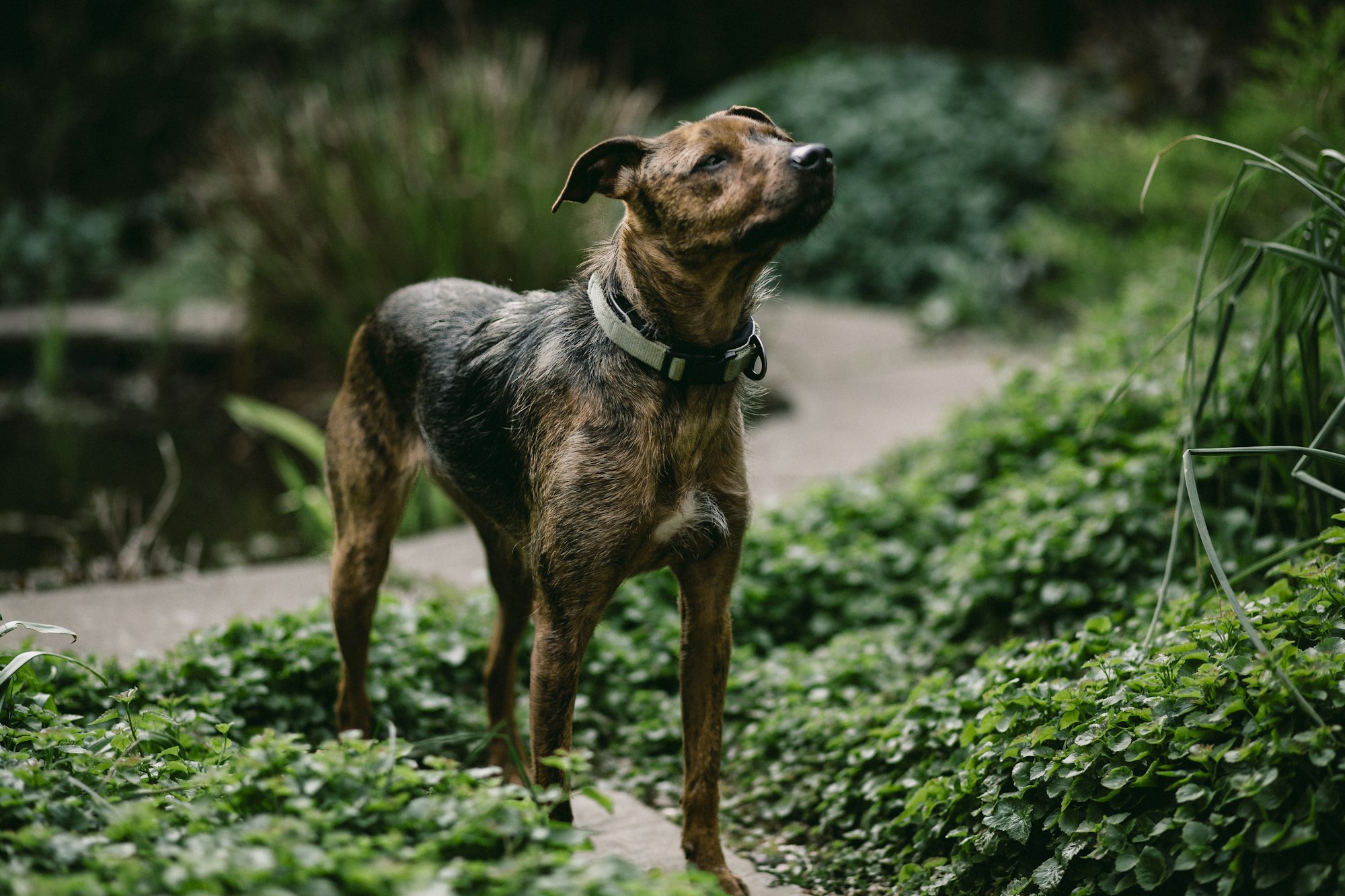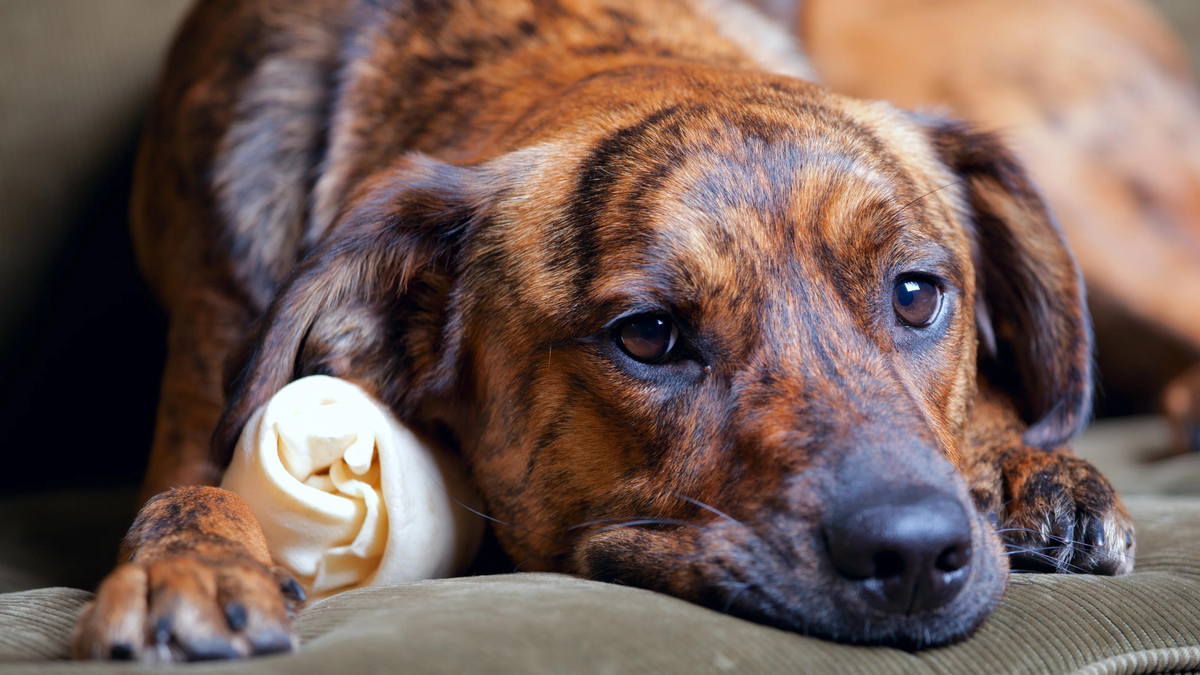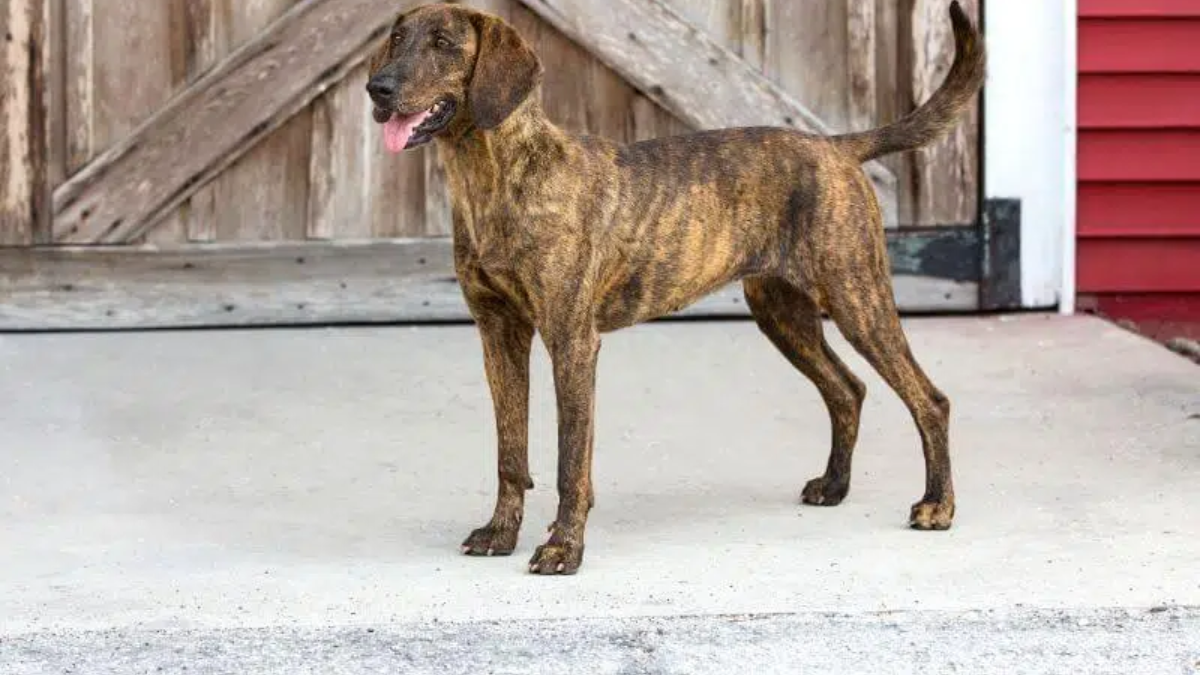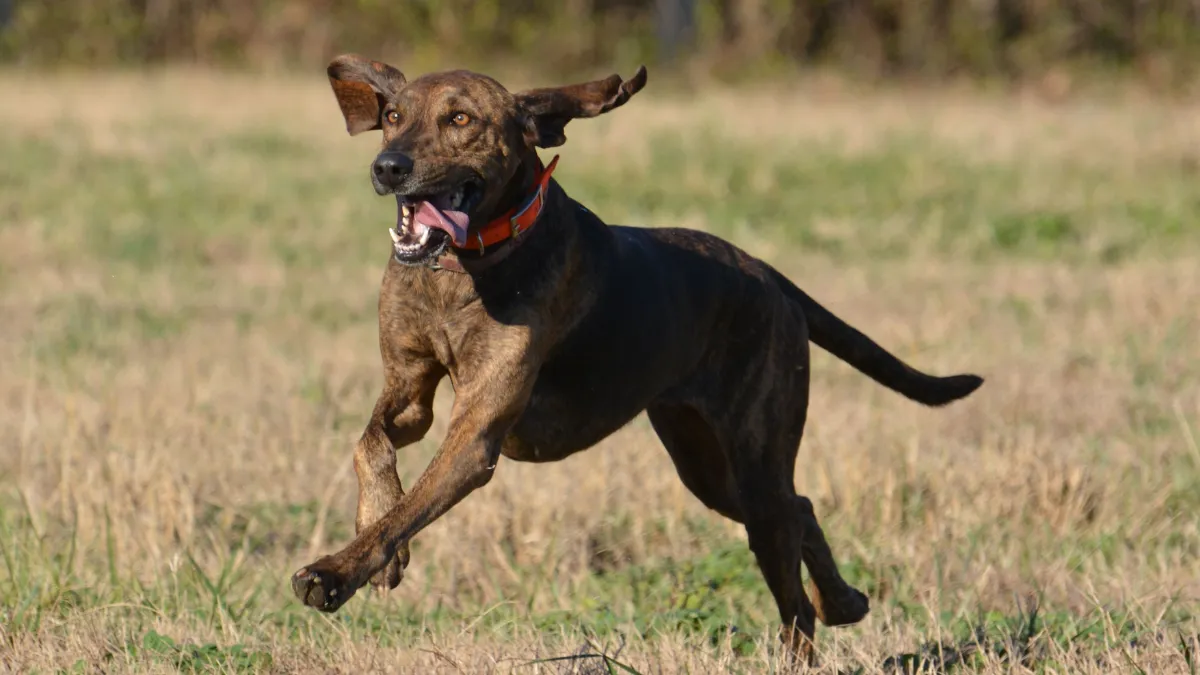Plott Hound, a name that might evoke images of a well-structured, lean, and determined canine. But how did it make the transition from being a fierce boar hunter to a cherished household companion?
In the verdant valleys of North Carolina, the birthplace of the Plott Hound, the stories began. Historically known for their relentless nature, these dogs were primarily used for wild boar hunting. They chased, cornered, and took down these robust animals, showcasing their resilience and courage. Avid hunters praised them for their unmatched abilities.
But like every tale with a twist, the Plott Hound's story was about to take a surprising turn.
Plott Hound Origins and History
Breed Development
The Plott Hound is a breed of dog that originated in North Carolina, United States. It is a medium-sized dog with a muscular build and a distinct brindle coat. The breed was developed by the Plott family in the 18th century for hunting purposes. The Plott family used various breeds of dogs, including Hanover Hounds, to develop the Plott Hound.
Plott Family Legacy
The Plott family has a long history in North Carolina and is known for their contributions to the development of the Plott Hound. The breed was named after the Plott family, who played a significant role in the breed's development and promotion. The Plott family's legacy is still evident today, as the Plott Hound is the official state dog of North Carolina.
German Roots
The Plott Hound has its roots in Germany, where the Hanover Hound was used for hunting wild boar. The Plott family brought the Hanover Hound to the United States and used it to develop the Plott Hound. The breed was recognized by the American Kennel Club in 2006, making it one of the newest breeds to be recognized by the AKC.
Understanding Their Needs
Bringing a Plott Hound into your life is like embarking on an exhilarating journey. They have high energy levels and require frequent exercise. A regular play session or a long walk is a must. Oh, and if you're thinking of a play companion for your Plott Hound, consider breeds like the Norwegian Elkhound or the French Brittany. Their energy levels can complement the Plott's quite well.
Also, let's address the elephant in the room – their diet. Can dogs have cinnamon? It's a question that many Plott Hound owners might ask, given their curious nature. While it's non-toxic in small amounts, always consult a vet before introducing anything new into their diet.
Grooming and Care
Plott Hounds have a short, bristly coat that's relatively easy to maintain. However, comparing their coat to breeds like Malamute vs Husky, one can easily notice the difference in thickness and texture. Regular brushing helps keep their coat in good shape, and it can be a bonding experience too!
Modern-Day Challenges for the Plott Hound Owner
While the Plott Hound's reputation has evolved, it's essential to understand that their intrinsic hunting instincts haven't disappeared altogether. New owners should be prepared to handle a dog with a relatively high prey drive, especially when introducing them to smaller pets or when they're in an open environment.
Socializing the Plott
Just like any breed, early socialization is key. Due to their strong hunting lineage, Plott Hounds might exhibit an inherent chase instinct, especially when they spot squirrels or birds during your regular walks. Early exposure to different environments, sounds, and other animals can help temper this instinct, making them more adaptable and well-rounded pets.
Training and Discipline
Training a Plott Hound can be a rewarding experience. Their intelligence and keenness to please their owners make them relatively easier to train compared to some stubborn breeds. Positive reinforcement techniques work wonders with them. They respond well to praises, treats, and play sessions after a job well done.
Health and Wellness
Although Plott Hounds are generally healthy dogs, like all breeds, they might be prone to specific health issues. Regular veterinary check-ups are crucial to ensure they remain in prime health. Furthermore, as they age, their dietary needs change. A balanced diet, coupled with regular exercise, can keep them fit and active for many years.
A quirky fact for potential owners: Some Plott Hounds can be pretty vocal, displaying a wide range of barks, howls, and other vocalizations. While some people adore this trait, it's something to consider if you live in a densely populated area or have neighbors close by.
Are Plott Hounds Hypoallergenic?
No, Plott Hounds are not considered hypoallergenic. Like many other breeds, they shed and produce dander, which can trigger allergies in sensitive individuals. While they have a short coat that requires minimal grooming, their shedding and dander levels can still pose a problem for those with allergies. It's important for potential owners with allergies to spend time with a Plott Hound before deciding to bring one into their home to ensure they do not have an adverse reaction.
Are Plott Hounds Rare?
Yes, Plott Hounds are considered relatively rare compared to more popular dog breeds. Originating in the United States, Plott Hounds are known for their excellent hunting abilities, particularly in tracking and hunting boar and other game. Despite their unique skills and loyal nature, they are not commonly found as pets outside of hunting and working dog communities. Their rarity can be attributed to their specific breeding for hunting purposes rather than widespread companion animal popularity.
Do Plott Hounds Bark a Lot?
Yes, Plott Hounds are known to bark a lot. As a breed developed for hunting, they have a strong instinct to vocalize, especially when they detect something unusual or are excited. Their barking is often a way to communicate with their owners and alert them to potential prey or intruders. While this trait makes them excellent watchdogs, it can be a challenge for owners who prefer a quieter dog. Proper training and socialization can help manage their barking tendencies.
Are Plott Hounds Good Family Dogs?
Yes, Plott Hounds can be good family dogs, but they require proper training, socialization, and exercise to thrive in a family setting. Known for their loyalty and protective nature, Plott Hounds form strong bonds with their family members and can be affectionate and loving companions. Their high energy levels and intelligence mean they need plenty of physical activity and mental stimulation. They can be good with children and other pets if properly introduced and trained, but their strong hunting instincts should be considered. Overall, with the right environment and care, Plott Hounds can make wonderful family dogs.
Do Plott Hounds Like to Cuddle?
Plott Hounds can be affectionate and enjoy cuddling with their families, but their primary nature as hunting dogs means they are also highly energetic and independent. They form strong bonds with their owners and appreciate attention and companionship. While individual dogs may vary, many Plott Hounds do enjoy cuddling after they have had plenty of exercise and mental stimulation. Providing them with ample opportunities to expend their energy can make them more likely to settle down and enjoy close, affectionate moments with their owners.
Are Plott Hounds Good with Cats?
Plott Hounds can be good with cats, but it largely depends on their individual temperament, socialization, and training. As a breed with a strong hunting instinct, Plott Hounds may have a natural tendency to chase smaller animals, including cats. Early socialization and positive experiences with cats can help mitigate this instinct and foster a peaceful coexistence. It's important to supervise interactions between Plott Hounds and cats, especially in the beginning, to ensure both animals feel safe and comfortable. With proper introductions and training, many Plott Hounds can live harmoniously with feline companions.
Do Plott Hounds Howl?
Yes, Plott Hounds are known to howl. As a breed developed for hunting, they use howling as a form of communication, especially to alert their owners or other dogs of their location or to signal the presence of prey. Their distinctive howl can be quite loud and is a trait inherited from their hound lineage. While this vocal behavior is useful in hunting scenarios, it can sometimes be challenging in a domestic setting. With proper training and management, their howling can be controlled to suit a household environment.
Do Plott Hounds Like Water?
Yes, many Plott Hounds do enjoy water and can be good swimmers, although their preference for water can vary from dog to dog. Given their history as hunting dogs, they often exhibit a strong, adventurous spirit and may enjoy activities that involve water, such as swimming, playing in streams, or splashing in puddles. While they are not specifically bred for water-related tasks like some other breeds, many Plott Hounds find water-based activities enjoyable, especially if they are introduced to them at a young age and have positive experiences.
How Fast Can a Plott Hound Run?
Plott Hounds are known for their impressive speed and endurance, capable of running at speeds up to 30 miles per hour. Bred for hunting and tracking, they possess the agility and stamina necessary to pursue game over long distances and challenging terrains. Their athletic build and strong legs contribute to their ability to run quickly and efficiently, making them excellent companions for active owners who enjoy outdoor activities like jogging, hiking, or participating in dog sports.
Do Plott Hounds Have Webbed Feet?
No, Plott Hounds do not have webbed feet. Unlike some breeds specifically adapted for swimming, such as Retrievers or Newfoundlands, Plott Hounds have standard paw structures without significant webbing between their toes. Their paws are well-suited for running and traversing rough terrain, which complements their history as skilled hunting and tracking dogs. While they may enjoy water and be capable swimmers, their feet are not specially adapted for aquatic activities.
Are Plott Hounds Protective?
Yes, Plott Hounds are known to be protective of their families. Originally bred for hunting, they have a natural instinct to guard and alert their owners to potential threats. Their loyalty and strong bond with their family members make them excellent watchdogs. Plott Hounds are typically wary of strangers, and their protective nature, combined with their keen senses, ensures that they will alert their owners to any unusual activities or intrusions. Proper training and socialization can help balance their protective instincts to ensure they are friendly and well-behaved in various situations.

In the end, a relationship with a Plott Hound, much like any pet, is built on trust, mutual respect, and a deep understanding of their needs. As the world continues to change and evolve, so does our relationship with this remarkable breed. Here's to a future filled with more tales of the Plott Hound: from its illustrious hunting days to its endearing role as a faithful companion.
Adopting a Plott Hound: Things to Consider
If the captivating tale of the Plott Hound has charmed you into considering one as a furry addition to your family, there are a few essential aspects you should contemplate.
Space and Environment
While they’ve transitioned beautifully into household pets, Plott Hounds are active and robust. They thrive in environments where they have ample space to run, play, and unleash their energy. A home with a backyard or easy access to parks would be ideal. Apartment living can work, but you'd need to ensure long, energetic walks and playtimes every day.
Companionship
Plott Hounds, with their sociable and affectionate nature, thrive on companionship. If left alone for extended periods, they can exhibit signs of separation anxiety. It's beneficial if someone in the household has a flexible schedule or if there are other pets to keep them company. A second dog, perhaps a different breed like the French Brittany or even a Norwegian Elkhound, can be a perfect playmate.
Adoption vs. Purchase
When considering adding a Plott Hound to your family, always look into adoption options. Numerous Plott Hounds are looking for their forever homes, and rescuing can be a heartwarming experience. If you're set on purchasing from a breeder, ensure they are reputable and prioritize the health and well-being of their dogs.
Costs and Commitment
Owning any pet, including the Plott Hound, comes with its set of expenses. From quality dog food to regular vet visits, toys, grooming, and unforeseen medical costs, it's essential to be financially prepared. Plus, they deserve the investment of your time. Training, socializing, exercising, and simple bonding moments will require a consistent commitment.
Preserving the Legacy: The Role of Plott Hound Enthusiasts
The remarkable journey of the Plott Hound, from the dense forests of North Carolina to modern living rooms, is nothing short of inspiring. This breed's continued relevance and adoration can be credited, in large part, to enthusiasts, breeders, and families who've championed its cause.
The Role of Breed Associations
Organizations like the American Plott Association play a pivotal role in ensuring the breed's future. These associations work tirelessly to:
- Maintain breed standards.
- Promote ethical breeding practices.
- Organize events to showcase the Plott Hound's versatility and talents.
- Offer resources to Plott owners, from training advice to health tips.

Promotion of Ethical Breeding
While the Plott Hound's popularity rises, so does the responsibility to protect it from unscrupulous breeding. Enthusiasts and reputable breeders emphasize the importance of ethical practices that prioritize the health and temperament of the breed over profits.
Embracing Technology with FI Dog Collars
The Plott Hound's story has been an evolution, adapting and changing with the times. As we move deeper into the 21st century, technology's role in the life of a Plott Hound owner cannot be ignored. One such innovation that's making waves in the canine world is the FI dog collar.
Ensuring Safety with FI
Plott Hounds, with their inherent hunting instincts and high energy levels, can sometimes be unpredictable during outdoor escapades. The FI dog collar, equipped with state-of-the-art GPS tracking, ensures you always know where your Plott Hound is. Whether they're chasing a squirrel or just exploring, you can have peace of mind knowing you can locate them with precision.
Community Involvement: Sharing through FI
FI isn't just about tracking; it's about community. FI users often share their dog's adventures, activity metrics, and favorite routes with fellow enthusiasts. Imagine sharing your Plott Hound's latest forest adventure, comparing their activity levels with a French Brittany, or discussing the stamina difference in a "Malamute vs Husky" race, all powered by the data from the FI collar.
Promotion of Ethical Breeding and Health
One of the underrated features of the FI collar is its ability to monitor a dog's activity levels. For breeders, this can be an invaluable tool. By understanding a Plott Hound's activity patterns, breeders can ensure optimal health and wellness, making informed decisions about care, diet, and exercise regimes.
Conclusion:
The Plott Hound's journey, from formidable boar hunter to a cherished companion, is a testament to the breed's adaptability and allure. As they transition into modern households, it's essential to understand their hunting lineage, their needs for space, socialization, and companionship, and to promote responsible adoption and ethical breeding.
Modern tools like the FI dog collar harness technology to ensure their safety, foster community engagement, and provide invaluable insights into their health and activity. With a harmonious blend of history, commitment, technology, and community, the future for the Plott Hound and its enthusiastic owners gleams with promise and potential.
FAQs
What is the origin of the Plott Hound?
The Plott Hound traces its roots back to North Carolina in the 18th century. Brought by the Plott family from Germany, they were initially bred for their exceptional boar-hunting skills.
Can Plott Hounds adapt well to apartment living?
While Plott Hounds can adapt to apartment living, they are energetic and require daily vigorous exercise. A home with a yard or easy access to parks is ideal. Regular long walks and playtimes are essential if living in an apartment.
How does the FI dog collar benefit Plott Hound owners?
The FI dog collar, equipped with GPS tracking, ensures that owners can always locate their Plott Hounds, especially given their high energy and propensity to chase. Additionally, it monitors activity levels, fostering community engagement and offering insights into the dog's health and patterns.
Are Plott Hounds suitable for families with other pets?
Yes, Plott Hounds are sociable and can get along well with other pets, especially if introduced and socialized early. However, their hunting instincts may surface with smaller animals, so supervision and training are crucial.
How can potential owners ensure they're getting a Plott Hound from an ethical breeder?
Research is key. Potential owners should look for breeders affiliated with recognized breed associations, ask for health clearances for both puppy parents, and visit the breeding premises to ensure the dogs are raised in a healthy, caring environment.
More info on Plott Hounds:



